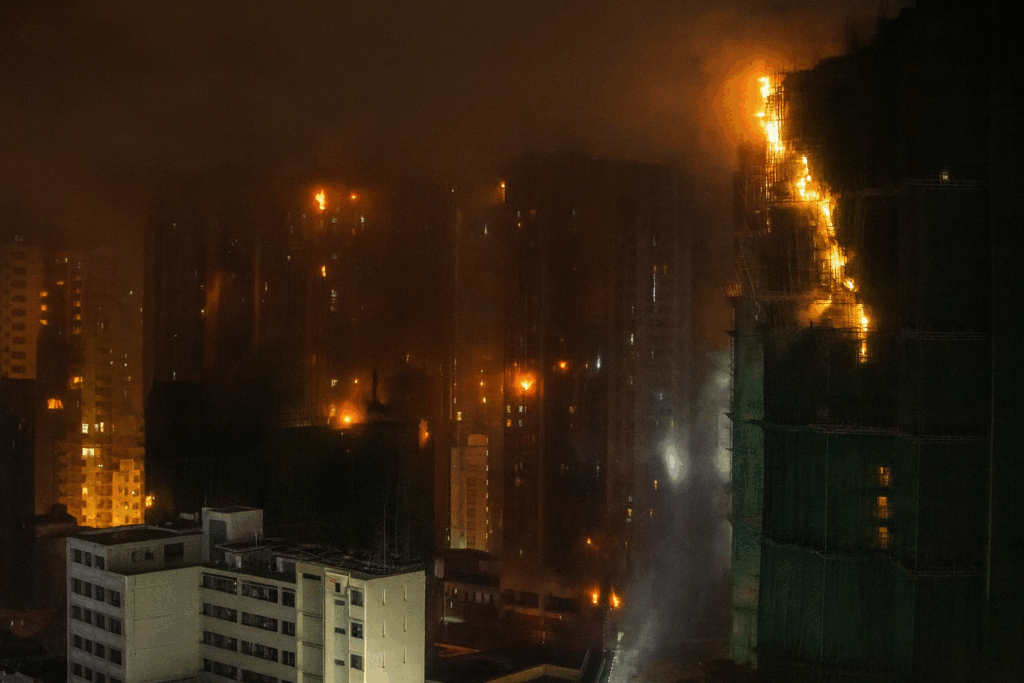A catastrophic fire that roared through a cluster of high-rise apartment buildings in Hong Kong’s Tai Po district on Wednesday left 13 people dead, more than a dozen injured, and hundreds displaced in one of the city’s most devastating blazes in decades. The inferno, which swept quickly across exterior scaffolding and into multiple residential towers, continued burning late into the night as exhausted firefighters struggled to reach those still trapped inside.
Nine victims were pronounced dead at the scene, and four others died in hospitals, authorities reported. At least 15 people were injured, and roughly 700 residents were evacuated to temporary shelters due to unsafe conditions caused by smoke and falling debris. Several residents remained unaccounted for, as emergency crews stretched rescue operations across multiple buildings.
The fire began in mid-afternoon and spread rapidly, driven by bamboo scaffolding and construction netting around the buildings for renovation. Strong winds carried flames from one of the complex’s eight towers, affecting nearly 4,800 residents across 2,000 apartments. The video showed sheets of fire and thick black smoke pouring from windows as night fell.
With the blaze escalating, the Fire Services Department raised the alert level to No. 5 — the highest in Hong Kong’s emergency rating system — as the fire spread vertically and horizontally across the facade. Hundreds of firefighters, police officers and paramedics were deployed, and ladder trucks were positioned to douse upper floors while teams attempted to breach smoke-filled stairwells inside the buildings.
The conditions for rescuers were described as perilous. “Debris and scaffolding of the affected buildings are falling down,” said Derek Armstrong Chan, deputy director of Fire Services (Operations). “The temperature inside the buildings concerned is very high. It’s difficult for us to enter the building and go upstairs to conduct firefighting and rescue operations.” His comments underscored the near-impossible task facing crews in the early hours of the emergency.
According to officials, the fire is believed to have originated on the exterior scaffolding of one tower, then spread inward and jumped to adjacent buildings. Windy conditions created a dangerous channel, allowing flames to leap across narrow gaps between structures. The Fire Services Department reported receiving “numerous” calls for help as residents sheltered behind closed doors, some of whom signalled to firefighters from their windows.
In total, the department deployed 128 fire engines and 57 ambulances to the scene. Among the dead was a firefighter who collapsed during operations, Fire Services Director Andy Yeung confirmed. Another firefighter continued receiving treatment for heat exhaustion. The loss of the responder prompted condolences from Chinese President Xi Jinping, who urged authorities to commit “all efforts to minimise casualties and losses.”
Local officials said many of those trapped early on were believed to be elderly residents with limited mobility. Lo Hiu-fung, a member of the Tai Po District Council, told local broadcaster TVB that rescue crews had difficulty reaching upper floors where older residents lived alone or required assistance.
District authorities opened temporary shelters for displaced families, many of whom fled with only the clothes they were wearing. One resident, who identified himself only by the surname Wu, told TVB he had no expectation of salvaging belongings. “I’ve given up thinking about my property,” he said. “Watching it burn like that was really frustrating.”
Tai Po, a suburban district in Hong Kong’s northern New Territories near the Shenzhen border, is densely populated and filled with ageing residential complexes. Bamboo scaffolding — a traditional construction method common across Hong Kong — has increasingly drawn safety concerns, and officials announced earlier this year that it would be phased out for public projects.
The disaster marks Hong Kong’s deadliest fire in years, recalling a 1996 commercial building blaze in Kowloon that killed 41 people and also reached a level 5 alarm. Investigators are expected to examine whether construction conditions, weather patterns or safety systems contributed to Wednesday’s tragedy.
Officials said rescue and recovery efforts would continue through the night as structural engineers evaluate the stability of the damaged towers. Further updates are expected once crews complete floor-by-floor searches of the affected buildings.


